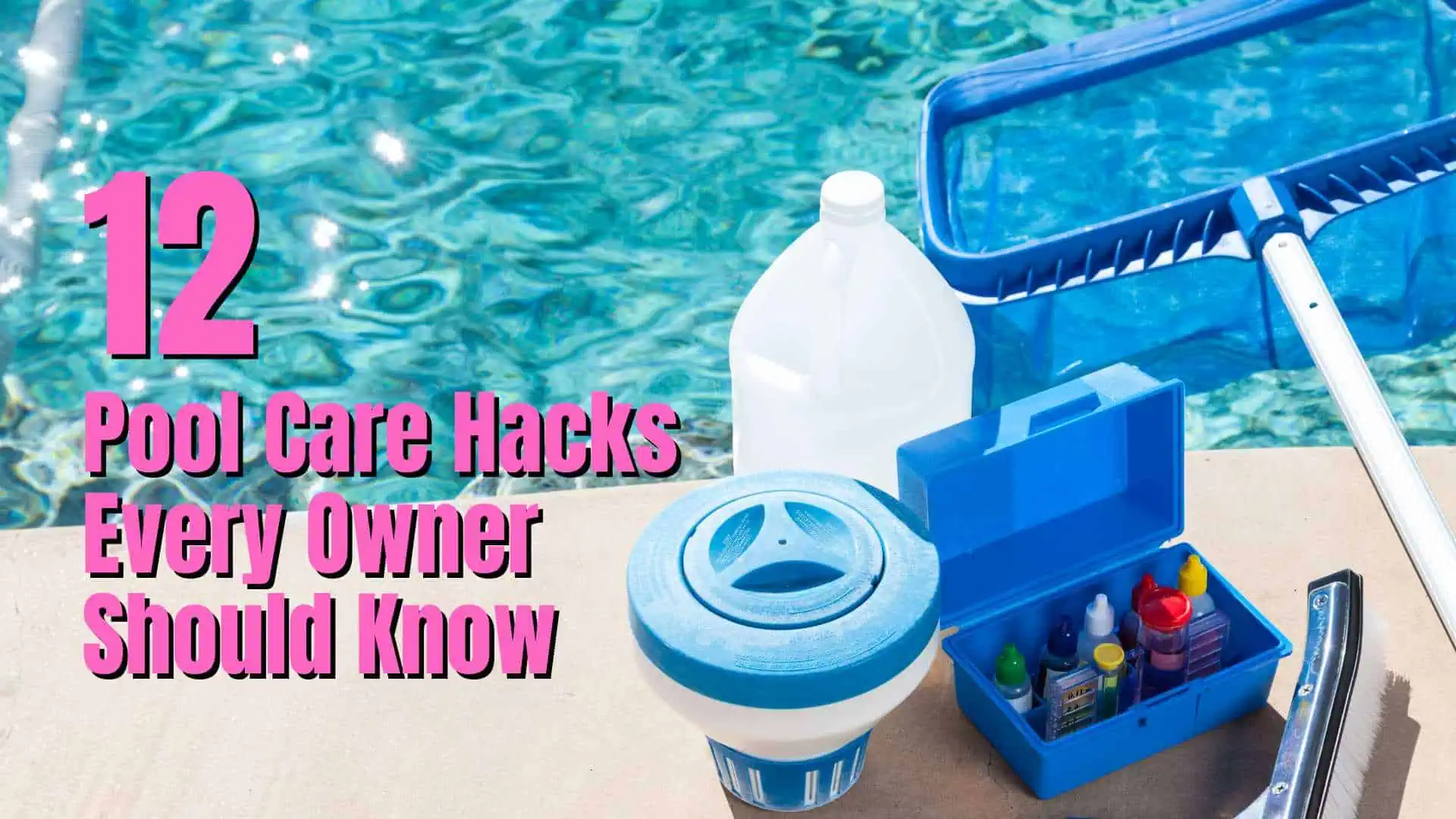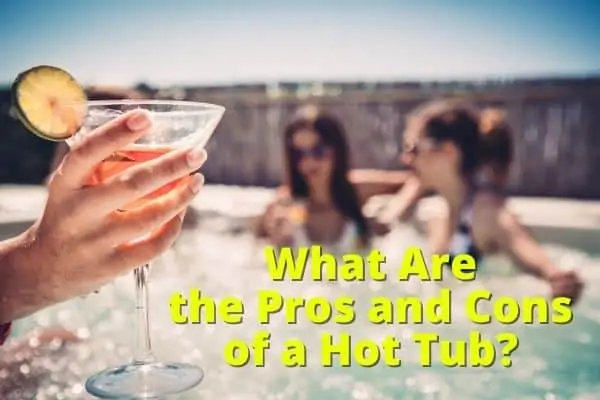Are you thinking of buying a solar cover for your pool? Solar pool covers, also known as solar pool blankets, involve quite a large investment, so ensuring that the expenditure will be worth it is important.
Generally, having a solar pool cover will save money in the long run, particularly if you heat your pool using electricity or gas. They will also extend your swimming season if you do not heat the pool and reduce the amount of money you spend on chemicals.
Are pool covers worth it? I will try to answer all your questions so you can make an informed decision about whether to buy a solar pool cover for your inground or above-ground pool.
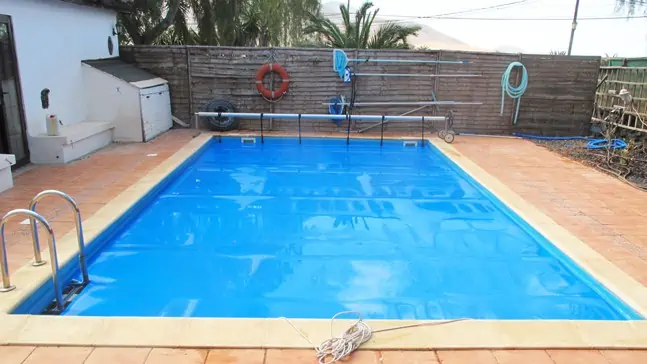

What is a solar pool cover?
A solar pool cover is basically a large solar blanket. It is similar to a very strong bubble wrap that floats on the pool’s surface. It doesn’t need to be attached to the pool, as the surface tension and its weight hold it onto the pool surface. In 9 years of having a solar pool cover, mine has never been blown out of the pool or lifted—and we get some pretty strong winds here.
It has bubbles on one side and a strong, flat layer on the other. The bubbles act as an insulator to prevent heat transfer from the pool.
A solar pool cover is different from a “pool cover.” A pool cover is intended to cover the entire pool to protect it during the winter and/or to prevent children or pets from falling in.
How do solar pool covers work?
A pool cover works in three ways:
- It floats on the pool’s surface, allowing the sun’s rays to enter and heat the water.
- It acts as a giant blanket and insulates the pool, greatly reducing heat loss, particularly at night and during windy weather.
- As no water is exposed to the air, evaporation is greatly reduced. The process of evaporation is one of the largest ways heat is lost from the pool.
Obviously, using the sun to heat a pool is very eco-friendly and can save you money if you use a pool heater.
Pros and cons of solar pool covers
Pros:
- A solar pool cover allows the sun’s rays to heat up the water in the pool.
- A solar pool cover helps retain the pool heat by insulating the pool water from the air above.
- You will save on water as there will be less water evaporation as it covers the entire surface of the pool, so it will prevent water loss into the air.
- Using a solar cover will extend the period you can swim in your pool by heating it up earlier in spring and longer into the autumn.
- In some ways, it is eco-friendly (and therefore electricity bill-friendly), as you will need to use your pool heater less. But of course, it is made of plastic, so this benefit may be offset in its manufacture.
- You should use fewer chemicals as the covered pool helps block UV rays, which break down chlorine.
Cons:
- The initial cost of the cover and a roller is quite high, but the roller will last many years, so that isn’t such an issue.
- Extra work is involved in removing the cover to swim, but not very much!
- The covers do not last forever, so need replacing from time to time
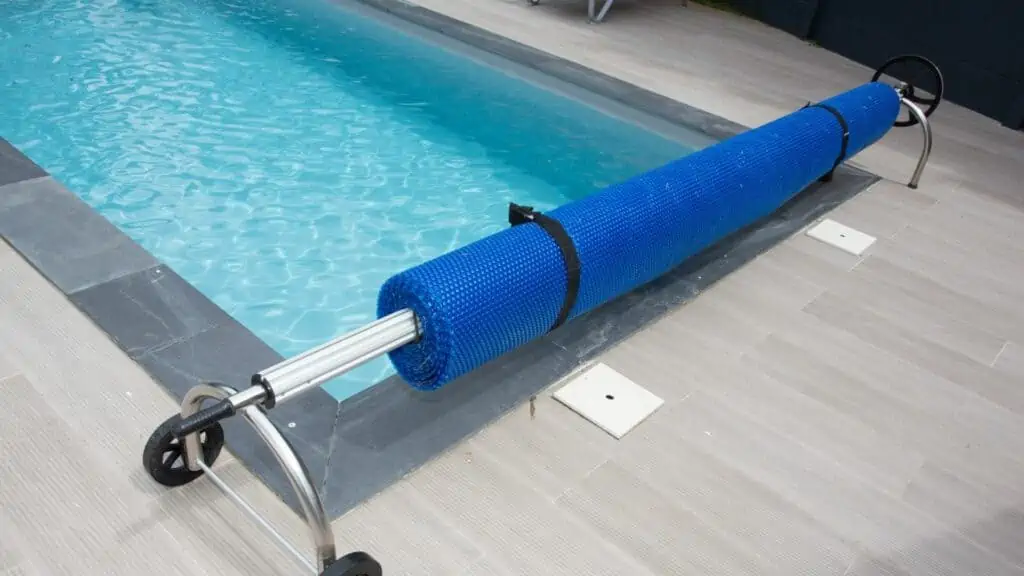
How fast does a solar cover heat a pool?
This obviously depends on many factors, such as the weather (whether warm and sunny or cool and cloudy), the air temperature, the wind, the cover thickness and color, and even the depth of the pool. See the sections below.
Its ability to heat the pool up is as much a factor in retaining the heat overnight as in heating it up during the day.
You can see daily gains of as much as 1-2ºF in good sunny weather.
Weather
This is hardly rocket science, but if the weather is hot and sunny, the pool will heat up much quicker than cool and cloudy. This is the same whether you have a solar cover or not.
Air temperature
If the ambient air temperature is high, the pool will generally heat up quicker and lose heat at night slower.
Wind
The wind greatly affects the pool’s temperature as pool water evaporates much quicker in windy weather (and loses heat as a function of evaporation in the same way as you cool down when you sweat and your sweat evaporates). With a pool cover, this heat loss is kept to a minimum.
Cover thickness and color
Solar pool covers vary in thickness, and it should be no surprise to hear that when it comes to the best pool solar cover thickness, the thicker it is, the higher the overall heat increase is likely to be. The lighter the color of the cover or the clarity, the more heat entering the pool will be (again, no surprise, I am sure).
Depth of pool
If you have a shallow pool, it will heat up quicker than a deep one. Without a solar pool cover to retain heat at night, a shallow pool will also lose heat quicker.
Solar cover bubbles up or down?
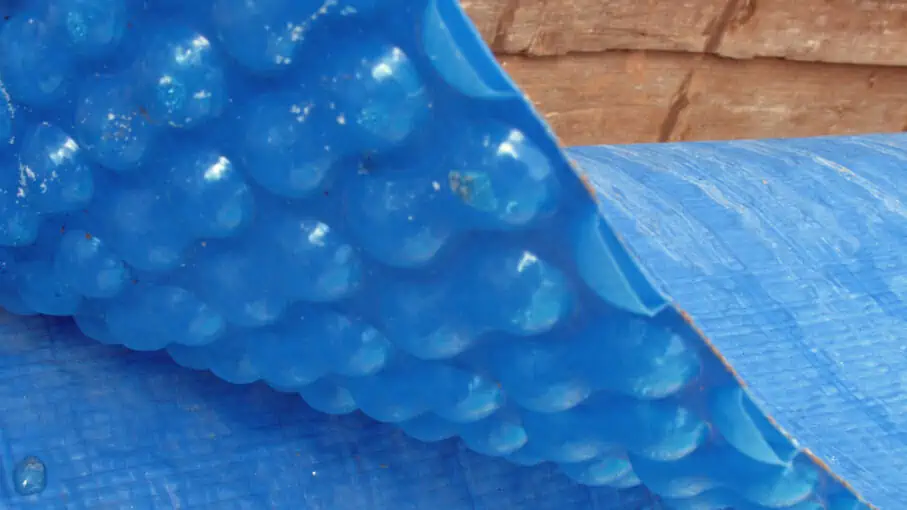
Believe it or not, the question of whether you put solar pool cover bubbles up or down is one of the most frequently asked questions on many pool forums. It is a good question as it is not really obvious.
However, the answer to the question of whether the bubbles go up or down on a solar cover is always that they bubble down into the water.
The bubble side has a larger surface area than the flat side, so heat is transferred into the water more efficiently than if the pool blanket were the other way around.
The bubbles contain air, which is heated by the sun and then transferred by conduction. The flat side is the tough side, whereas the bubble side is generally the least tough side. So, having the bubbles facing down on the pool’s surface means they are protected from anything that may drop in the pool.
The smooth side, therefore, faces upwards. Its smoothness also makes it easier to clean. You can run the hose over it before you remove it from the pool.
My experience of using a solar cover
We live in the Canary Islands, which are off the coast of North Africa, so the climate is pretty warm generally. We have solar heating panels on the roof, which obviously heat the water up quite well, but without a solar cover, much of that heat is lost overnight.
We are not masochists and don’t want to die of shock when we get in the pool, so we want the temperature to be at least 82ºF/28ºC before we put a toe in.
Before we bought the solar cover, we usually managed to swim comfortably from mid-April until mid-October. With the solar cover, we are often in the pool by early March and swim until mid-November at least.
My pool normally loses 1.5-2ºF overnight without the cover on but hardly loses anything overnight when it is on.
In the summer, on a sunny day (which most are here), without our solar heating on, I often see an increase of 2-3ºF during the day when I have the solar cover on.
Interestingly, we had a power outage for just over 24 hours last summer, and I had the pool cover on. My wife and I wanted to swim late afternoon, so I rolled the cover back, and we went in. The water temperature in the top foot was much higher than the water below by at least 10ºF.
Of course, the pool pump had not been running, so the water had been undisturbed, which is why this was so noticeable. But that does show what a good job the cover does to warm up the water.
It was amazing how the warmer water had such a defined edge to the cooler water below. It was not a gradual transition from hot to cool as I would have expected, but a sudden change.
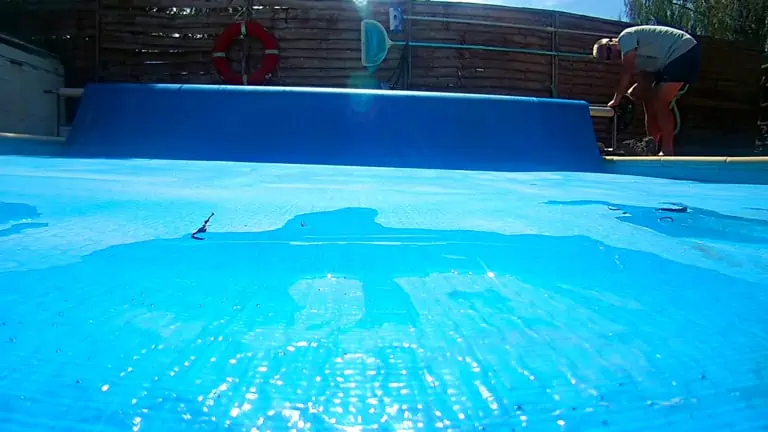
Does a pool warm up faster with the cover on or off?
On a hot, windless day, the pool water may heat up quicker with the cover off, as more of the sun’s energy will reach the water.
However, the pool cover also helps stop heat loss and evaporation, and this loss happens quicker in windy conditions, so it may heat up quicker with the cover on.
In my experience, it makes very little difference, so leaving it on is rather easier than keeping the cover on and taking it off.
Should I leave the solar pool cover on during the day?
If the weather is warm and sunny, with little wind, you may see a slightly higher increase in the pool’s temperature if you remove the cover during the day. This would probably only be true if you took it off for just the hottest hours of the day.
Once the sun starts to go lower, you may lose as much, if not more, heat due to evaporation than you gain from the sun.
What color solar cover works best?
Pool cover colors can make a difference in the amount of heat that enters the pool and the amount of heat retained in the pool.
Dark blue covers tend to be better at retaining heat than allowing heat to enter the pool.
Clear pool covers will allow heat into the pool the best but will not retain it as well as a dark color.
Light blue covers are a happy medium between letting heat in and retaining heat, which is probably why they are the most common color.
A few different colors are available now (even gold) and some two-color covers, with one color on one side and another on the other.
What is the best pool solar cover thickness?
There are a few things to consider when it comes to choosing the thickness of your pool cover.
| – lighter, so easier to cover and uncover the pool | Thick covers (16 mils) |
| Pros | Pros |
| – cheaper | – more durable |
| – lighter, so it is easier to cover and uncover the pool | – longer lasting |
| – let more heat directly into the pool | – retain heat better |
| Cons | Cons |
| – tear easier | – heavier, so it is harder to cover and uncover the pool |
| – do not last so long | – more expensive |
The normal range of solar cover thicknesses runs from 8 mils to 16 mils. A mil is one-thousandth of an inch (0.001 inches).
12 mil solar covers are the most popular thickness as they do a good job all around, are easy to handle and last quite a few years.
When it comes to solar blankets, you really get what you pay for. Buying cheap can be a false economy.
Some of the best solar pool covers are available from Sun2Solar. They produce them in all shapes, sizes and colors.
Sun2Solar Rectangular – from 10ft x 16ft to 30ft x 60ft
Sun2Solar Round – from 12ft to 33ft diameter
Sun2Solar Oval – from 10ft x 15ft to 21ft x 41ft
How does a solar cover go on or off?
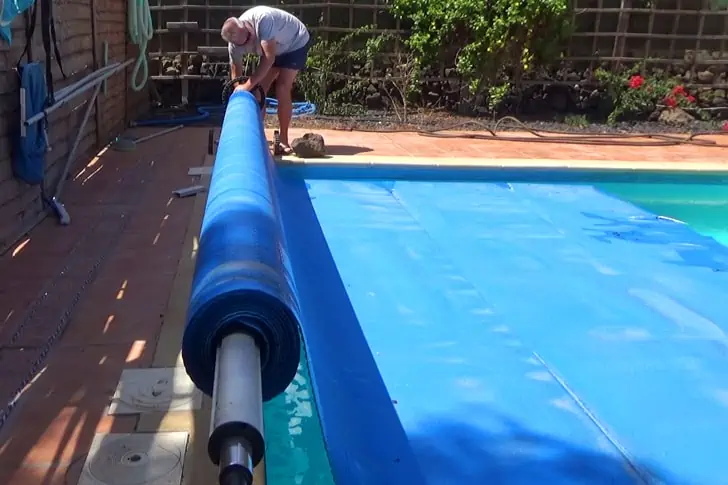
Manual roller or reel: This is the most popular method of removing and putting on the cover. The solar cover is attached to the roller, so when it is wound up, the cover rolls up around it until it is off of the pool completely. Most rollers have wheels at one end, so you can wheel them out of the way when swimming if necessary.
To put the cover on, most will have a rope attached to the free end. You can pull from the other end of the pool so that the cover unwinds as you pull. You can also unwind the roller slowly; the cover will float on top of the pool until it is fully unwound.
Electric roller: These are similar to the manual roller but are operated electronically at the press of a button.
Manually: Theoretically, it would be possible to pull a solar cover on and off and fold or roll it up manually when not used. But that would be very difficult and impractical, particularly if it is a big pool. Doing it this way makes you much more likely to tear or damage it in some way, so it wouldn’t last very long. It would also be such a pain to put on and take off that you probably wouldn’t bother with it at all after a while.
One of the best solar cover reels is the VINGLI Pool Cover Reel Set, which comes with all the fittings that can be attached to a solar blanket and is easy to assemble. It fits all pool shapes/covers.
Pool Care Handbook and Video Course
When I bought my house with a swimming pool, I knew absolutely nothing about pool care. I just winged it for a while, making many mistakes along the way.
Fortunately, I was recommended Swim University’s Pool Care Handbook and Video Course. I bought it and it was an absolute game-changer.
It was the best money I spent that year. I learned everything from basic cleaning to advanced troubleshooting. Swim University offers a no-quibble refund policy too so what do you have to lose?
Can you use a solar cover in the winter?
Well, to a large extent, this depends on your climate and whether you want to use the pool year-round.
Cold winter climates
If you live somewhere with very cold winters, perhaps with heavy snowfall and hard frosts, the answer is most definitely no. Your solar cover will need replacing much quicker in a climate like this. If your weather is so cold that the water freezes, then there is a good chance that the solar cover will be damaged beyond saving by becoming frozen.
If money is no object, and you keep your pool heated throughout the winter in such a cold climate and swim in it, then it may be worth using a solar cover in the winter, too. You are unlikely to gain much heat from the sun by keeping it on, but the thermal qualities of the cover would help to retain heat.
You may find that the money you save on heating costs covers the cost of renewing the cover should it be needed.
Warm winter climates
If you live in Arizona, Florida or parts of Australia, it may be possible to use the cover in winter to enable year-round swimming by keeping the pool warm. The cover is less likely to become damaged without extreme weather.
What do I do?
The climate is great here in the Canary Islands, with the lowest temperatures rarely dropping below 50ºF at night and 68ºF during the day in winter. But there is insufficient sunshine to keep the pool at a temperature that we are prepared to swim in (we hate the cold), even with our solar heating and the solar cover.
So, from around mid-November until late February or early March, I take the cover off and store it. See the next section for tips on storing.
How to store a solar cover in winter
Apart from UV light (more of that in a moment), another thing that makes your solar cover degrade quicker is the chemicals in the pool. So if you just remove the cover and store it, then it will still have these chemicals and dirt on it. These will continue to act upon the cover while it is stored. So before you store the cover, you should wash it with soapy water.
Ideally, you should do this in an area large enough to lay it out flat, such as a terrace or a driveway. Lay it out and then hose it down. Afterward, wash a bucket of soapy water with a soft broom to remove as much as possible. Then, hose it down again. You should do this on both sides and then leave it to dry completely before rolling it up.

Once dry and rolled up, you need to protect it from the winter weather and UV (Ultraviolet) light. Even the winter sun can produce enough UV to degrade the cover. That is ideal if you have somewhere inside you can store it, such as a large garage. If you cannot store it inside you can buy a cover to protect it quite cheaply in a size to fit yours.
Can you use a solar cover on an above ground pool?
Solar pool covers work just as effectively on above ground pools as they do on in-ground pools so there is no reason not to have one.
You can even use a roller to wind them in and out as rollers can be purchased and attached to the side of the pool.
Does a solar cover stop the pool from getting dirty?
Although some seem to suggest that solar covers do at least help keep the pool clean, in my experience, this is not one of their benefits. There is always a small gap between the pool sides and the cover, so dirt and debris often get blown towards the edges and then enter the pool.
Also, to keep the cover in good order, it is good practice to hose any dirt off the cover before you roll it up so it ends up in the pool anyway while you are using it or when you roll it up.
Does a solar pool cover cause algae?
Solar pool covers do not cause algae to grow. It may be argued that as the water temperature increases and algae grow faster in warmer water, algae growth can be accelerated by using solar cover.
However, the counterargument might be that algae grow best in full sunlight, so as most solar pool covers, particularly the darker ones, reduce the amount of sunlight that reaches the water, they can prevent algae growth.
In practice, I think it makes little or no difference. At least I have never had algae growth in my pool since using one for the past 6 years.
Can you run a pool pump with a solar cover on?
Absolutely, and you should run it too. Your pool pump should run for the same amount of time each day when the solar cover is on as it does when it is off.
The water still needs to be filtered, and the chemicals circulated, whether on or off. The solar cover will not be damaged when the pump is running.
Does a solar cover have to cover the whole pool?
Ideally, a solar pool cover should cover the whole pool—well, all but an inch or so around the edges to allow gases to escape.
Having said that, even a solar pool cover that covers only half of a pool will help retain heat in the water.
How long do solar covers last?
Generally, the thicker the cover, the longer it will last. If you store the solar cover under cover or away from UV rays over winter and take care of it during the summer, you may get 5 years out of it, but it could be as little as 3 years.

I have to say this is my one bugbear with solar pool covers. Their one function in life is to be in full sunshine and float on water containing strong chemicals, so why can’t they be made to withstand that better? Why can’t the manufacturers solve this problem? But that’s just me, I guess.
Over time, the UV light starts to rot the plastic, and it starts to disintegrate. Individual bubbles start to come away (and end up all over your yard). You have to bite the bullet and replace it at that point.
Other types of solar pool cover
Liquid solar covers
This is a relatively new phenomenon. It is basically a form of alcohol that floats on top of the water and prevents evaporation (which is where most heat loss occurs). It sounds rather bizarre, but it has been shown to work.
It is very easy to use, as you just pour in some more every so often to maintain its effectiveness. Although you cannot swim with a plastic solar pool cover still on the pool (obviously), you can with a liquid solar cover, so there is less work involved. The FDA has approved it as safe to use and swim with.
Liquid solar covers are not recommended for use in very windy areas, though.
It does not damage the filtration system in any way. In fact, as it forms just a thin layer on top of the water, very little of it will actually be pulled through the filtration system.
The most popular liquid solar cover on Amazon is the Natural Chemistry Swimming Pool COVERfree Barrier Layer
Solar sun rings
These are rings of solar blanket, normally with a floatation ring around the outside, thrown onto the surface of the pool and acting in the same way as a full solar pool cover. It can take quite a few to cover a large pool.
They are easier to remove and replace and also to store over winter since they can just be stacked up.
They do have some drawbacks. They leave areas of the pool surface exposed. Because of that, they are less effective than a conventional solar pool cover at stopping evaporation and heat loss.
These are available on Amazon – Solar Sun Rings
Bubble wrap
Many people ask if you can use bubble wrap as a solar pool cover. Laying bubble wrap over the surface of a pool may work to some extent, mainly because it will reduce the evaporation of the pool water (a major cause of heat loss). However, it will not be very effective at increasing the heat that enters your pool.
One major drawback is likely that as bubble wrap is so light, any breeze may lift it and send it flying across your yard.
Solar Pool Cover FAQs
Do solar covers really heat the pool?
Solar pool covers definitely help heat pool water. They do this by trapping the sun’s rays and almost completely eliminating evaporation, which is one of the main ways a pool loses heat.
Are solar pool covers worth the money?
In most cases, a solar pool cover is worthwhile as it can extend the swimming season by as much as two months (one month in the spring and another in the autumn).
How quickly will a solar cover heat a pool?
Solar covers can increase the temperature on warm sunny days by as much as 2ºF. In a period of good weather, this could equate to 10-15ºF per week.
Should I take my solar cover off during the day?
Taking a pool cover off during the day will cause the pool to heat less quickly than if it were left on. However, if you put it back on at night, it will at least retain the heat overnight.
Also read: If you have the opposite problem and want to cool your pool then our post How to cool pool water in summer may help.
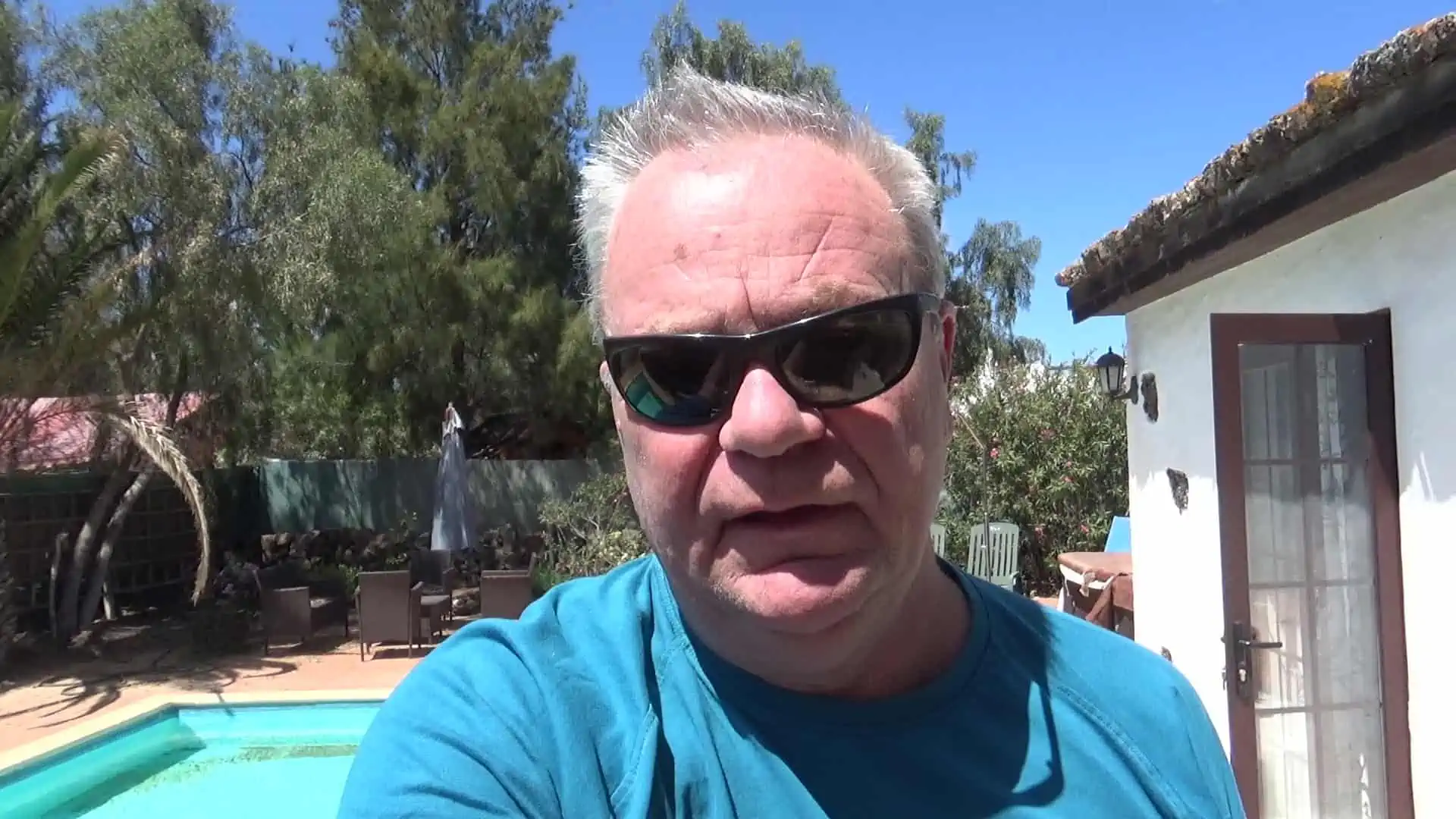
I have had hot tubs for over 20 years and a pool for the last 10 years. I had to learn how to clean, maintain and fix them the hard way. Since then I have helped many friends and neighbors with their pools and now I want to share everything I have learned with you. About Me




